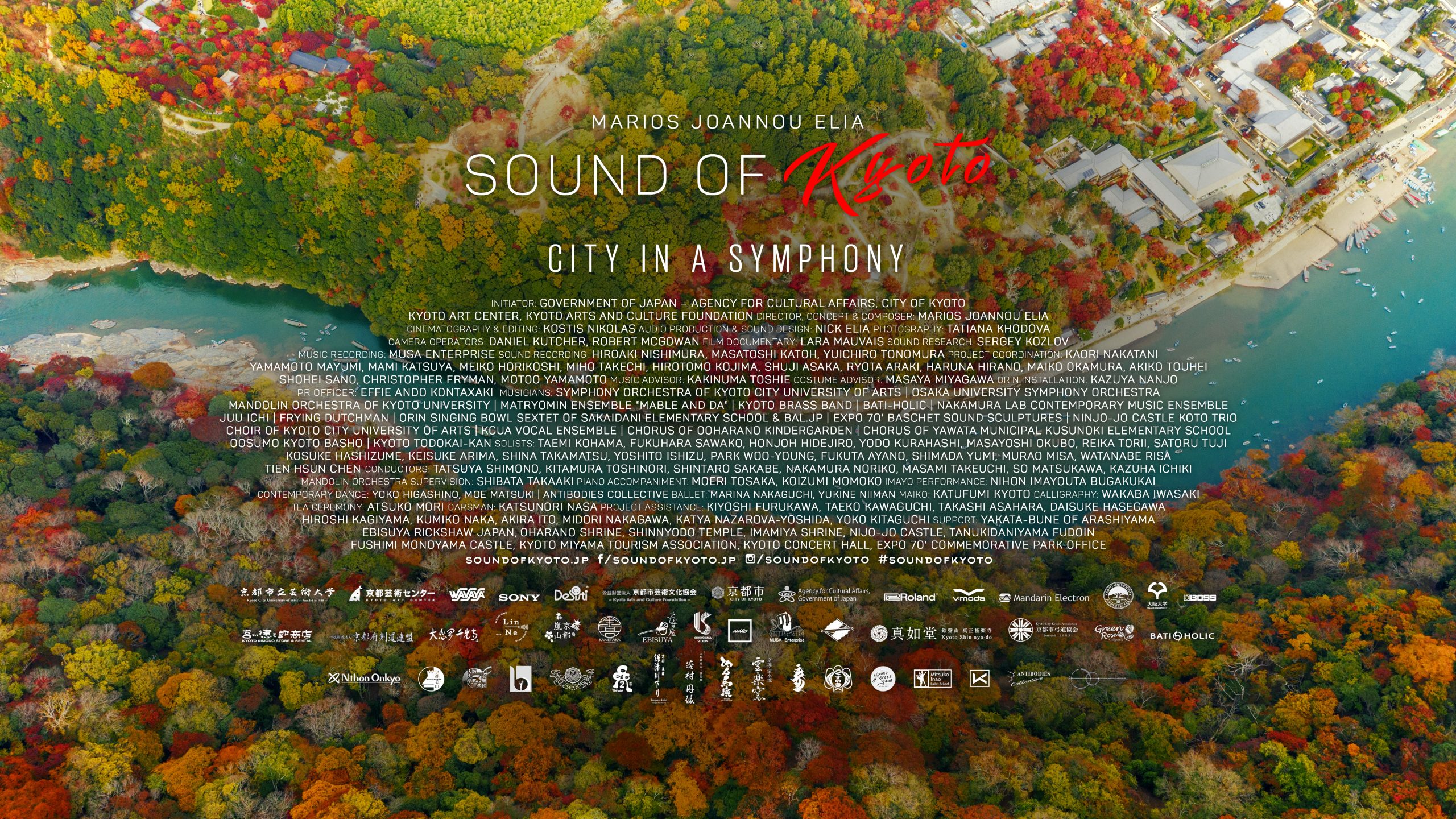Sound of Kyoto | Marios Joannou Elia
"Sound of Kyoto" is a contemporary audiovisual portrait of the city. The entire city is the scenery and the stage on which the music is performed and the city’s voice is heard.
Sound of Kyoto, Kyoto, Japan, Marios Joannou Elia, Kostis Nikolas, Sound of Vladivostok
4
home,page-template-default,page,page-id-4,eltd-core-1.0.3,ajax_fade,page_not_loaded,,borderland-ver-1.15, vertical_menu_with_scroll,smooth_scroll,paspartu_enabled,paspartu_on_top_fixed,paspartu_on_bottom_fixed,wpb-js-composer js-comp-ver-5.4.7,vc_responsive

都市の交響曲
Sound of Kyoto
City in a Symphony
「どの街にもそれぞれの『音』があるのだろうか?」。マリオス・ヨアンノー・エリアは、日本の文化、歴史の核心でもある都市、京都でその答えを探した。“Sound of Kyoto”における彼のコンセプトは、都市というもの全てを「音楽化」するという冒険的かつ型破りな試みであり、連続した時間の中で発生する、音による多面的構造をとっている。
視覚的美観をもつ都市の豊かな遺産を内包した個々の音は、新たな一つの構成の要素となっている。そこでは、京都という物語を語る音楽的な宇宙が展開される。560人以上の音楽家の演奏と京都の精神を捉えた自然音を混合させることで、“Sound of Kyoto”は県全体に、現代音楽による「声」をもたらした。
1000年以上のあいだ日本の首都であり、自然の詩情に満ちた景観をもつ京都は、音楽が奏でられ、街そのものの音を聴くことができる「ステージ」である。そこには数々の室内、戸外を問わない場所が含まれている。例えば鹿苑寺金閣、祇園の花街、シューボックス式である京都コンサートホール、嵯峨野の竹林、嵐山の牧歌的な風景、茅葺き屋根の風景が残る美山村、日本最古の繊維工場の一つである川島織物などである。
紅葉により、秋の京都は鮮やかな色に満ちた季節となる。絵に描いたような秋の景観に、山、川、橋、寺院、神社、路地の風景による調和が織り交ぜられるのだ。そうした調和は音楽のポリフォニー的知覚が生来持っているものでもある。日本の伝統楽器、電子マトリョーミンアンサンブル、合唱、オーケストラ、マンドリンオーケストラもそうした知覚を持っている。
突き詰めていくと、“Sound of Kyoto”とは鮮やかな音楽と映画のような映像を融合した、「フィルム・コンサート」である。エリア氏は“Sound of Vladivostok”(2017)で極東ロシアの「音」をコンセプトとして最初に採用しました。ドイツでこの作品は「観客はこれまでに存在しなかった、真のオーディオヴィジュアルの一形態を目撃することになった。新たな芸術形式が生み出されたのだ。」と評された。
“Sound of Kyoto”は日本国文化庁、京都芸術センターの後援のもと制作された。
Does each city have its own sound? Marios Joannou Elia is in search of the answer to this question in Kyoto, the cultural and historical heart of Japan. His concept “Sound of Kyoto” aims in an adventurous and unconventional way to musicalise the city in its entity and create a polytope of acoustic and musical events happening in a continuous timeline.
Distinct sounds that encapsulate the city’s rich heritage along with their visual aesthetics are used as sources for the creation of a new composition in which a musical cosmos unfolds that tells the story of Kyoto. “Sound of Kyoto” gives a contemporary musical voice to the entire prefecture, blending performances from over 560 musicians with natural sounds to capture Kyoto’s soul and spirit.
Being the imperial capital of Japan for more than a thousand years and filled with the poetry of nature, Kyoto is the scenery and the “stage” on which the music is performed and the city’s “own” voice is heard. Dozens of indoor and outdoor locations are included, such as the Kinkaku-ji Temple with the Golden Pavilion, the Geisha District Gion, the shoebox-style main hall of Kyoto Concert Hall, the Sagano Bamboo Forest, the idyllic landscape of Arashiyama, the rural village Miyama with its authentic thatched roof houses, and Kawashima Selkon Textiles, one of the oldest weaving mills in Japan.
Autumn in Kyoto is a vibrantly colored season thanks to the red and yellow leaves of autumn foliage. The picturesque fall scenery interwoven with the harmony of mountains, rivers, bridges, temples, shrines and alleys is inherent in the polyphonic perception of the music that includes Japanese traditional instruments, an electronic matryomin ensemble, choirs, symphonic and mandolin orchestras.
Ultimately, “Sound of Kyoto” is a film concert that blends a vibrant surround sound experience with cinematic images. Referring to “Sound of Vladivostok”, Elia’s first application of the concept “Sound of” in Far East Russia (2017), a German critic put it this way: “The audience witnessed a genuine audiovisual format that has not existed before. A new art form has been invented.”
“Sound of Kyoto” has been commissioned by the Agency for Cultural Affairs of the Government of Japan, the City of Kyoto and Kyoto Art Centre.
新闻 | NEWS
Kyoto in Symphony: The highly anticipated film Sound of Kyoto comes to its coda – Tokyo Weekender
Composer Marios Joannou Elia Captures The Sound of Kyoto in His Latest Short Music Film– Tokyo Weekender
Japan Sound Portrait Podcast 47: Sound of Kyoto
Un ciné-concert pour ressentir l’âme de Kyoto, cœur culturel du Japon – Euronews (France)
Ο μουσικοσυνθέτης που έκανε γνωστό το όνομα της Κύπρου ανά το παγκόσμιο – REPORTER
“Song of Kyoto” une symphonie musicale enchantée de la ville japonaise – Africa News
«Ο Ήχος του Κιότο»: Ο Μάριος Ιωάννου Ηλία συνθέτει το μουσικό πορτρέτο της πόλης – Euronews (Greece)
Kiotó hangjai: egy birodalmi központ zenei lenyomata – Euronews (Hungary)
“Sound of Kyoto” veröffentlicht offiziellen Trailer – Sumikai
Ενας Κυπριος συνθετης κατακτα την Ιαπωνια με τη μουσικη του (A CYPRIOT COMPOSER CONQUERS JAPAN WITH HIS MUSIC) – CNN
“Marios Joannou Elia: The composer who enchants the Japanese” – ERT
The Music of Polymediality – ALPHA News
Creating the Musical Identity of Kyoto – CNN
The Musical Notes of Life – Interview with Down Town
The Composer who Hears a Symphony in Everyday Sounds – Sunday Mail
プロジェクト参加者 スタッフ随時募集中 | Project participants and Staff Wanted
アーティストトーク | Artist Talk | 28.09.2018
De Sisti partners with unique film project “Sound of Kyoto”
撮影インターン募集 | RECRUITING INTERNSHIPS
約 | ABOUT
批評家の称賛 | CRITICAL ACCLAIM
“Composer Marios Joannou Elia orchestrates a masterpiece of sound dedicated to Kyoto” Tokyo Weekender
“A groundbreaking musical work that reflects the identity of the city” CNN
“Α magical polytope of the city, capturing its exuberant mosaic … A colossal achievement” EURONEWS
“A spectacular audiovisual portrait and a work that praises Japanese culture” ERT
舞台裏 | BEHIND-THE-SCENES
560 人の音楽家 | 43 の協力機関 | 18 の書き下ろし曲 | 1.650 の録音 | 4.000 の短編映像 | 10.300 の記録写真 | そして一つの都市
560 MUSICIANS | 43 INSTITUTIONS AND PARTNERS | 18 ORIGINAL COMPOSITIONS | 1.650 RECORDED SOUNDS | 4.000 VIDEO CLIPS | 10.300 DOCUMENTARY PHOTOS | 1 CITY
報道 | PRESS

